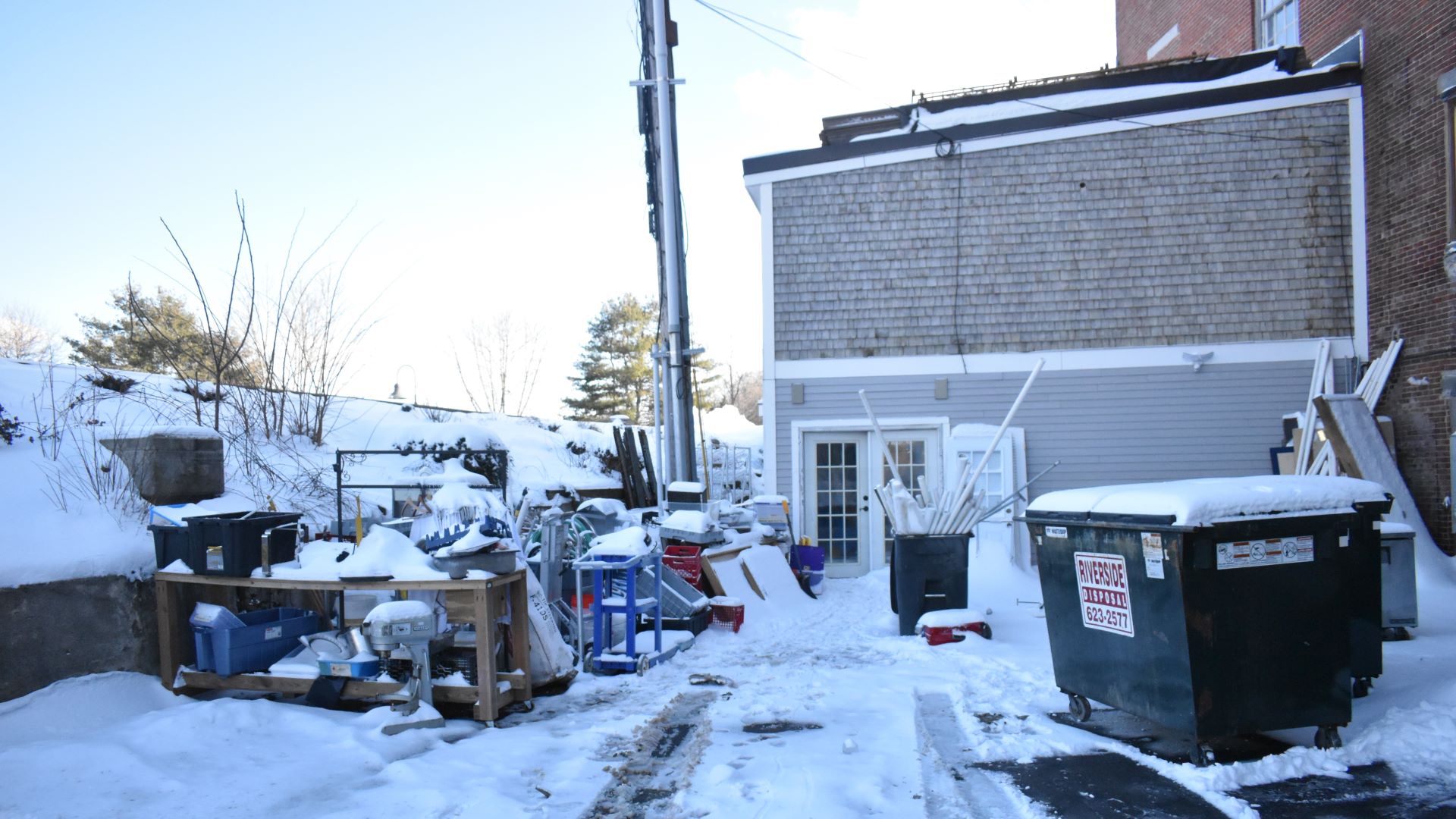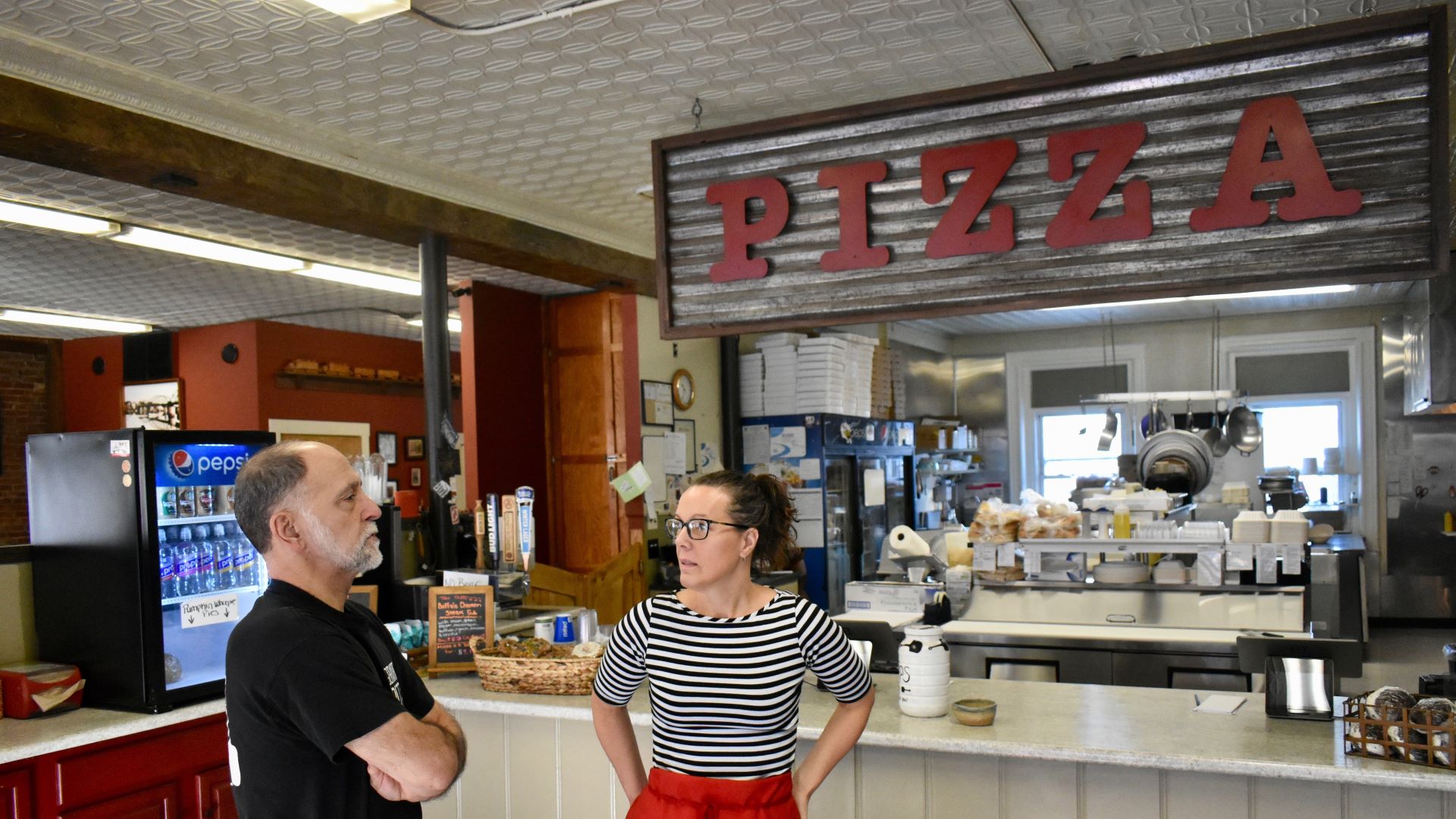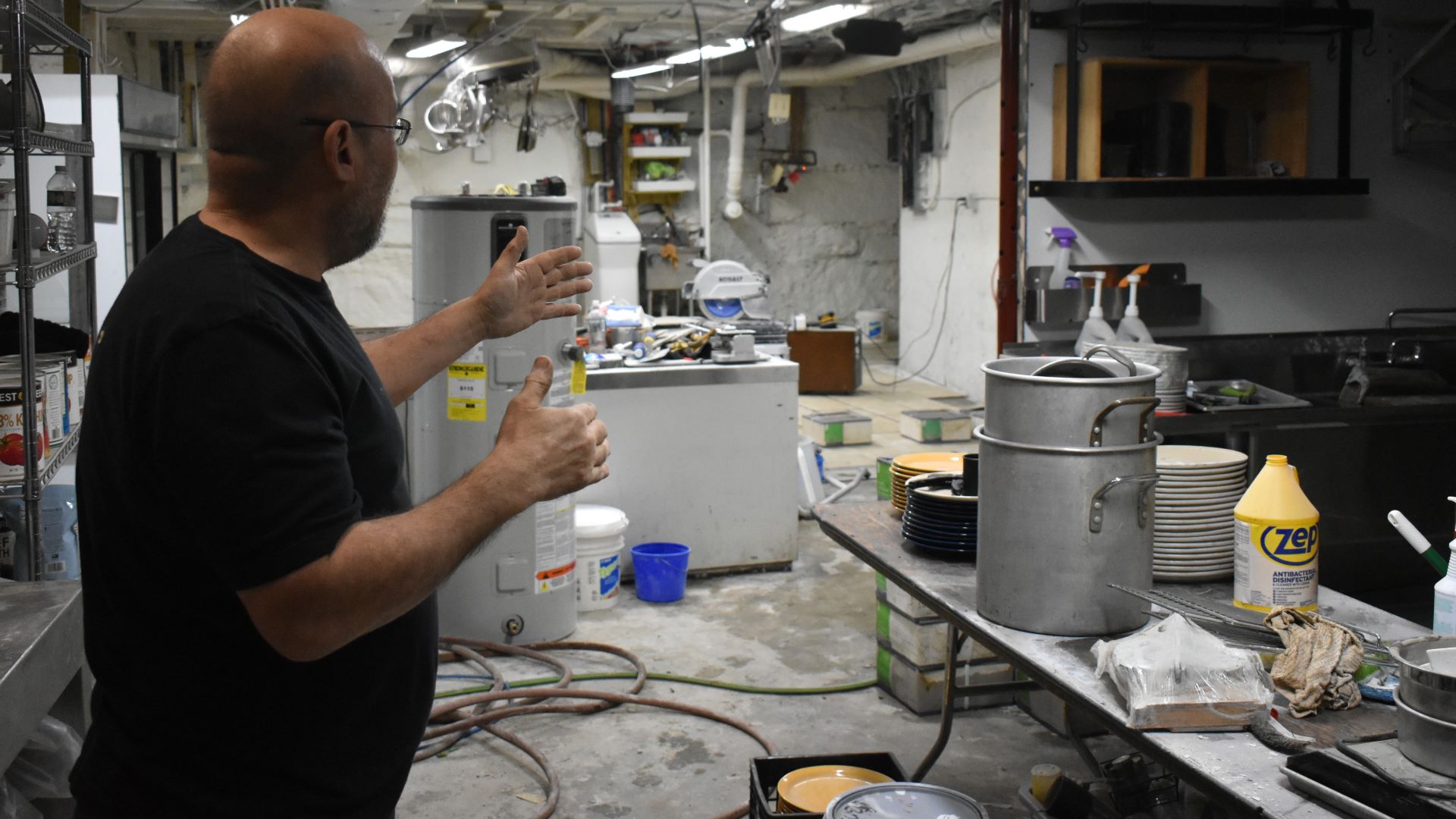A foot and a half of murky water had already breached the brick walls of Bintliff’s Corner Brew cafe in Gardiner last month when Roger Bintliff made a last-ditch effort to save the restaurant he had owned for almost five years.
Bintliff, a 56-year-old veteran restaurateur, waded through icy waters in the pitch-black basement with only a headlamp illuminating his path. Desperately he attempted to set up a water pump to send the floodwaters back toward the swollen Kennebec River.
But the water rushed in quicker than it could be expelled, and before Bintliff knew it, he also was in danger.
“That water came so fast. It went from about 18 inches to 5 feet within two hours. I was actually in the water trying to get this pump going when I realized, ‘This ain’t stopping,’ ” Bintliff said in an interview with The Maine Monitor .
Bintliff decided to escape, but as he headed to the stairway out of the basement, he noticed an obstruction.
“My refrigerators started floating and tipping over, blocking my doorways,” Bintliff said. “I had to swim underneath them to get out and I had to abandon the pump.”
Ultimately, Bintliff made it out safely, but his cafe did not. His refrigerators, water heater and over $100,000 worth of equipment were damaged beyond repair.
Now, a month after that devastating Dec. 19 flood, Bintliff and other business owners up and down Water Street in Gardiner are discovering that their insurance policies will not cover their flood damages. Many of them are small business owners with their whole lives sunk into their stores, and the news that they lack coverage is a gut punch.
The same sad story is replaying throughout the state after a string of historic storms blamed on human-caused climate change. On Maine’s coast, fishermen and homeowners are recovering from back-to-back storm surges this month that flattened dunes, untethered docks and destroyed fish houses.
And along the Kennebec River, some residents in Gardiner, Hallowell and Augusta are fighting with insurance companies after the raging river flooded their businesses in December.
When that storm hit last month, Bintliff thought he was OK. He had invested in a hefty insurance policy that would cover up to $400,000 in damages. A Liberty Mutual insurance agent had helped him settle for it after Bintliff learned the cost of his previous flood insurance policy had increased and would not cover damage to his possessions, Bintliff said.
“I said if they’re not going to cover contents during the flood, I’m not worried about my 200-year-old granite building floating down the river,” Bintliff said.
But when it came time to file a claim, Bintliff learned the policy would not cover the cost of the flood damages.
For Bintliff, it was because the content insurance he doubled-down on, like most non-flood insurance policies, did not cover losses stemming from flood damage. Had Bintliff lost his equipment to a fire, he would have been covered, but not by a flood.
Bintliff takes full responsibility for the mistake, yet still feels scorned by his insurance company for standing idly by as he made it.
“I can’t blame anybody. I’m the businessman,” Bintliff said. “I’m the idiot paying $16,000 a year in insurance. So shame on me for not paying attention.”
However, Bintliff said, “They literally just sign me up over the phone … and make sure that you have a policy, but they place you with companies that don’t cover anything that happens to people along the Kennebec River or in Maine.”

(Liberty Mutual did not respond to a request for comment regarding Bintliff’s interaction with its agents.)
As Maine riverfront and coastal communities prepare for wetter and more frequent storms, sea level rise and flooding that experts attribute to human-caused climate change, they also must reckon with the intricacies of a flood insurance market with narrow definitions and, for most flood-prone properties, increased premiums.
Bintliff, for example, cited an increased cost to his previous flood insurance two years ago as the reason he dropped his policy.
That increase resulted from an updated payment structure for a nationwide flood insurance plan backed by the federal government, called the National Flood Insurance Program.
The NFIP was established by an act of Congress in 1968 as more and more private insurance companies pulled out of the flood insurance market.
But as time passed and natural disasters ravaged the country, starting with Hurricane Katrina in 2005, the NFIP began paying out significantly more than it was taking in, resulting in greater and greater debt for the program’s operator, the Federal Emergency Management Agency.
The answer? Raise premium prices for customers whose properties have a greater flood risk and decrease them for those with less flood risk.
The program, called Risk Rating 2.0, meant flood insurance customers like Bintliff, whose cafe is precariously positioned near the Kennebec River and its tributary, the Cobbosseecontee Stream, saw their premiums increase by last spring.
In fact, most NFIP policyholders in the Gardiner area saw their annual premiums increase.
Of 184 policyholders in the area, roughly 67% experienced an increase, according to data analysis from the Association of State Floodplain Managers, a Wisconsin-based nonprofit that analyzes flood policy with the goal of reducing flood loss.
A little over 15% of all Gardiner policyholders had their annual premiums increase by over $200 per year, that analysis shows.
And while the increase became intolerable for people like Bintliff, other Gardiner property owners must purchase flood insurance if their buildings are in a flood zone and financed by a federally backed mortgage or loan.
Up Water Street, for example, the owners of Gerard’s Pizza had an NFIP flood insurance policy through American Bankers Insurance Company of Florida, also called Assurant, because they had a mortgage on their building.
Like Bintliff, owners Stacy and Claude Caron were shocked when they found their insurance policy — which specifically covered floods — would not cover the more than $35,000 worth of equipment damage from the December flooding.
That’s because the insurance policy the Carons signed up for only covered their building, not its content. In an interview with the Monitor, Stacy Caron described a matter-of-fact phone call with an insurance agent about their NFIP policy, which Caron said was presented as the only option.
“We don’t even remember there being a discussion at the time with the insurance company. It was just a phone call that said, ‘You guys need flood insurance, you know, this is what it’s going to cost,’ ” Caron recalled. “So we’re like, ‘OK,’ because that’s what you’re supposed to do.’”
What was even more maddening for the Carons was the decision by an insurance adjuster last month to recommend denying their claim for the water damage to the building’s first floor, which they felt certain would be covered by their NFIP policy, unlike their content.
Caron said the floodwaters completely filled the restaurant’s basement and seeped through the tile floors in the kitchen, ruining them. But while the Carons saw what they considered obvious flood damage, the adjuster had doubts, Caron said.
“He said he didn’t think that that would be covered because he can’t prove that the water damaged it,” Caron said. “We were speechless. You feel like you’re at the mercy of this guy … Like you’re three feet tall.”
A spokesperson for Assurant did not comment on the Carons’ specific claim, which is still open, but said Assurant agents are held to specific training standards through the NFIP and state insurance departments.
Similarly, FEMA spokesperson David Mace cited that training and added, “FEMA makes every effort to ensure that policyholders are aware of their flood risk as well as the specifics of their individual NFIP policy.”
Mace also referenced a legal requirement for FEMA to supply policyholders with corresponding information when they open or renew an NFIP policy and a FEMA online resource that walks through the appeals process for denied claims.

Up the Kennebec River in Hallowell, another business, Easy Street Lounge, is in a similar situation. According to the lounge’s GoFundMe page, many required repairs will not be covered by flood insurance.
The roughly $15,000 already raised for Easy Street will go to “(r)ent, licenses, electric/gas bills, building a new bar, glassware, furniture, barstools, lights, (liquor) and beer inventory, and much more that flood insurance won’t cover,” according to the page.
The experiences of Bintliff, the Carons and others are not uncommon, according to Robert Jerry, former dean of the University of Florida’s law college and an insurance law expert.
It can happen both ways, where consumers feel hard-done by their insurance providers or they make outright mistakes that lead them away from proper flood insurance coverage, according to Jerry.
“I think it’s unfortunate, especially in the flood market, that consumers make these mistakes a lot,” he said in an interview. “It’s not uncommon for people to say that, you know, ‘I was misled by the agent who was processing my application.’ And it certainly happens,” but some fault lies with the consumer.
“This is certainly true in hurricane country, that a lot of people” don’t understand their basic homeowners insurance policy will not cover flood damage, for example.
Bintliff, however, had a complaint that resonated with some insurance law discussions, according to Jerry. And that is whether insurance companies have a responsibility to provide a level of informed consent, similar to that of a doctor, when explaining or tailoring an insurance policy to their customer.
“The argument has been made through the years that the broker or agent breached a duty to explain the coverage that they were selling,” Jerry said. “Although there are some cases to the contrary, the general rule has been that an insurance agent or broker does not have a duty to explain this type of coverage.”
Without this level of transparency, Bintliff projected that hundreds of business and home owners up and down the Maine coast who were impacted by the major floods on Jan. 10 and Jan. 13 would be coming to the same jarring realization, that their insurance policies will be useless in recouping losses.
Only about 1% of Maine property owners have flood insurance, according to a FEMA estimate. That accounts for 7,700 of more than 600,000 total property owners.
Bintliff said that like him, many business owners may have to decide whether to sell their flood-damaged properties should the cost of reopening be insurmountable. That could lead to a chain of closures and low interest in buying the risky properties, damaging communities.
“A lot of people are focused on trying to get open, trying to get their business going,” Bintliff said. “But when you crush the small-business entrepreneur, you’re crushing the lifeblood of these towns.”
The Hannaford’s supermarket a short walk to the north of Water Street remains closed, like Bintliff’s cafe, which was hit especially hard because most of his equipment was stored in the basement.

Caron, however, remains hopeful that Gardiner rebounds. Gerard’s reopened shortly after the flood, due in large part to assistance from community tradespeople, who quickly restored electricity and fixed the flood-damaged kitchen floor.
The December flooding, which saw the Kennebec River crest around 22 feet upstream in Hallowell, about 11 feet above flood stage, was not the first time Gerard’s Pizza fell victim to rising waters. Claude Caron still remembers the April Fools Day Flood of 1987, which sent waters two feet higher than the more recent flood, and another major flood in the 1970s.
But each time Gardiner flooded, the Carons returned to their pizza parlor and continued to serve the community.
“We’ve been serving (Gardiner) for almost 60 years and they are fantastic,” Caron said.
The day before the December wind and rain, the Carons were slinging sandwiches for business owners preparing for the storm and anyone else who needed them, according to Aaron Harris, owner of A1 Diner on Bridge Street.
“You’ve got people who are literally throwing away thousands of dollars of stuff that they can’t afford to throw away and they’re more worried about … people who need to eat,” Harris said of the Carons.
“They deserve that flood coverage. They deserve better than they’re getting.”
Both Caron and Harris, whose dumpsters were whisked away downstream during the December floods, described a need for community resiliency in the face of more flooding.
That means, Caron said, sitting with new property owners in Gardiner to explain the risks of flooding, and the ins and outs of flood insurance.
“We don’t talk about what can go wrong (or) what you do when some disaster happens,” Caron said. “So I think that’s definitely a conversation that needs to be had.”
That’s a topic for Gerard’s new owner, the Carons’ daughter, Kasha Gray. Now that Gray owns Gerard’s outright, without a mortgage, Caron said they would ditch the restaurant’s flood insurance policy.
“I mean, if you think for the past six years, we’ve spent $40,000 in flood insurance to have not covered anything,” Caron said. “So why should she spend $40,000?”
The premium’s high cost isn’t worth the struggle they saw with their current claim, and the fact they have to pay for repairs out of her husband’s retirement fund only adds to the damage.
“It just … changes what life (will) look like for the foreseeable future,” Caron said.







